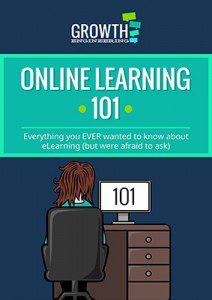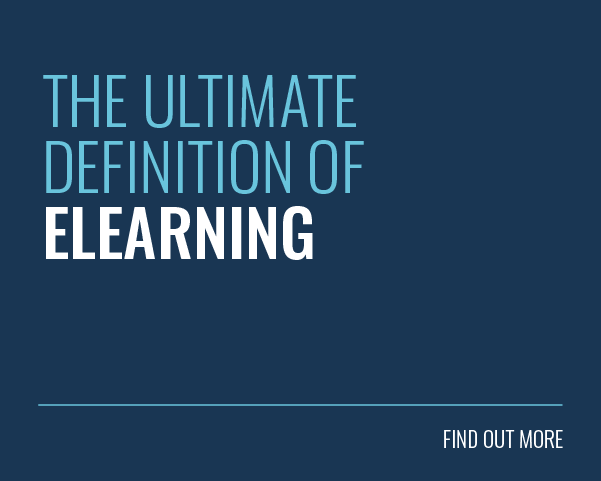What is Online Learning?

Online Learning, eLearning, Distance Education; call it what you will, training employees online has grown to become a multi-billion-dollar industry. Despite its success, many business leaders and decision-makers are still unclear about what online learning actually is, and misconceptions about price and effectiveness are still rife.
Since 2004, we’ve encountered all of the common objections to online learning: online learning can’t compete with classroom training, or online learning can’t hold employees’ attention, but training people online needn’t be as terrifying as you might assume.
The benefits of online learning are almost too many to mention, but it’s important to realise that every company is different, and it’s up to each one to weigh up the pros and cons of online learning for themselves.
With all the talk of SCORM files, HR system integrations and automated reporting, online learning can seem a confusing subject to the newcomer. To make the transition to a cloud-based training solution a little easier, here’s a list of the common terms you might encounter on your journey.
How does Online Learning work?
The last decade has seen outstanding advances in internet technologies which have created a wealth of options for training employees online. Online learning is now available on mobiles and tablets, as well as desktops, making it a flexible, secure and scalable training solution.
Generally speaking, online learning is delivered via a learning management system. On a basic level, this platform lets learning managers and administrators:
- Add and co-ordinate learners
- Upload training content
- Push the training to the learners
- Report on the learners’ progress
Because the learning management system is online, everyone from managers to employees can access it whenever they like, and wherever they are. This makes it very convenient to manage the training for a global workforce and it means that new starters can complete their onboarding – even before their first day on the job.
The freedom and flexibility of online learning also future-proofs it for changing working patterns, meaning even casual workers can receive all of the training they need in their own time.
It seems too good to be true – and for some, it will be. eLearning might not necessarily be suited to every employee, every organisation or every situation. Here are the pros and cons of online learning to help you see if eLearning is right for you:
The Pros and Cons of Online Learning
Pro: easily accessible
Employees can log on to their LMS anytime, anywhere, anyhow. All they need is an internet connection and the means by which to take eLearning (a desktop computer, laptop, tablet or even a mobile phone).
Con: requires technical skills

Now, learners don’t have to know how to code, but they will need to understand the very basics of using computers and the internet, and basic troubleshooting. For instance, how to take a screenshot when submitting a bug report, or how to use a mouse/trackpad to drag and drop quiz answers within a time limit. Some more sophisticated software might require a steeper learning curve over and above what employees might feel comfortable with, but LMS creators like yours truly realise not everyone will have experienced using these kinds of systems before – that’s why we offer full Admin training and advice!
Pro: Can be used to supplement classroom training
Going for an online learning option doesn’t mean you’re never allowed to see your learners in person! A ‘blended’ learning approach can be very useful as it can ensure a deeper level of understanding is achieved. Employees can take training online under their own steam, then come to a training workshop event fully armed with the knowledge they will then be discussing. This can really help to cement the training more deeply.
Con: face-to-face training will always be costly

You might be thinking about moving your training online because of the costs involved in classroom-based training. There’s no denying that it’s expensive to put employees through face-to-face training, and we’re not just talking about paying a tutor and booking a venue.
You’ve also got to think about the costs involved in taking employees away from their desks for a day or two, travel expenses, food and drink costs, and any other costs that might crop up.
Unfortunately, blended learning is associated with similar costs. After saving money using online learning, you’ll still have to spend the cash to bring your employees together. However, there’s no denying that blended learning is a cheaper, more effective option than solely classroom-based training – the amount of time spent away from the desk is reduced, fewer workshops are required, and information is reinforced in learners’ minds more thoroughly.
Pro: no waiting around

Employees who wish to take training won’t have to wait around for the next training event or sign up months in advance. Instead, they can simply express their desire to undertake the eLearning, log on to their LMS, access the content and go for it. This results in a workforce which is much more skilled and ready to take on challenges. It also means that learners can progress through training at their own speed – so, for instance, a part-time worker can still take advantage of the training, but take their time over it. Compare this to a part-time worker having to attend the same training course as a full-time worker and you can see the benefits.
Con: dragging it out
Although employees being able to take training as and when needed is a huge benefit, it’s not without its problems. For instance, some employees might not be as dedicated to their eLearning as others – meaning that while most employees have completed all the required work and passed their course, some are lagging behind. It can then be difficult to motivate them to carry on and pick up the pace.
This last point highlights the importance of securing learner buy-in. Without learners’ dedication and engagement, you can’t be certain they will complete their training in the timeframe you hoped for. There are ways to overcome this issue, though – we make sure learners are engaged with their training through the use of gamification (badges, points, levels, leaderboards) to make online learning more fun. Check out how we do this below!
The Engagement Crisis
 Online learning has changed the game when it comes to training employees, but its arrival hasn’t been without teething problems. Learning managers are coming to realise that earlier attempts at online learning solutions have failed because they didn’t put enough focus on engaging the learner.
Online learning has changed the game when it comes to training employees, but its arrival hasn’t been without teething problems. Learning managers are coming to realise that earlier attempts at online learning solutions have failed because they didn’t put enough focus on engaging the learner.
These ‘legacy’ learning platforms were designed merely to fulfil the basic function of giving learners access to training material. As these systems failed to produce any real behavioural change, learner engagement became recognised as more of a priority.
Today’s learners spend a large part of their time engaging with a multitude of online platforms and this has ingrained a subconscious expectation for a certain level of quality. To maintain their credibility, learning management systems and other instructional technology need to meet the standards set by the most popular apps and services.
Fixing the Engagement Problem
Getting learners engaged with online learning can seem like a riddle too complicated to ever solve, but we believe that the key to engagement is to give your learners something that they enjoy and want to come back to again and again. With an approach focused on engaging the learners, there’s no reason why your training programme shouldn’t be a roaring success from the moment you roll it out to everyone in the company.
The issue of engaging learners online is easiest to solve when you stop thinking of your training platform as an LMS, and start thinking of it as a machine for driving engagement throughout the organisation – an ‘Engagement Engine’ if you will.
An Engagement Engine uses 3 main tools to engage learners.
- Personalisation: Custom features and personalisation options make the training more relevant, meaning the organisational goals are filtered down through the whole experience.
- Gamification: Adding game mechanics to the system makes the learning experience more fun, more exciting and more compelling for the learner.
- Social Features: Features like discussion boards, live chat and news feeds help build a learning community, capitalise on informal learning and capture organisational knowledge.










